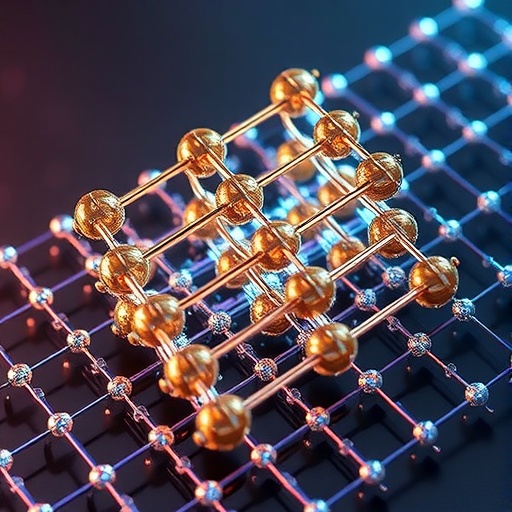In a groundbreaking advancement within condensed matter physics, researchers at Okayama University have unveiled compelling evidence of a spontaneous lattice distortion in the spin-triplet topological superconductor CuₓBi₂Se₃ as it transitions into its superconducting phase. This discovery, accomplished through the use of high-resolution synchrotron X-ray diffraction, challenges long-standing assumptions in superconductivity and opens novel avenues for understanding the interplay between exotic electronic states and crystal lattice dynamics.
Superconductivity—the phenomenon whereby materials conduct electricity without resistance—has historically been understood as involving electron pairing that leaves the host lattice essentially unchanged. Conventional superconductors, well described by Bardeen-Cooper-Schrieffer (BCS) theory, exhibit such behavior with electron pairs forming singlets that do not disturb the lattice symmetry. However, the emergence of topological superconductors, which host unconventional pairing symmetries and exotic quasiparticles such as Majorana fermions, has complicate this picture. These states promise transformative applications in fault-tolerant quantum computing, but their fundamental properties, particularly their coupling to crystal lattices, have remained elusive.
The research team led by Professor Guo-qing Zheng utilized synchrotron X-ray diffraction—a technique famed for its unparalleled spatial resolution—to detect minute lattice distortions on the order of 100 parts per million in CuₓBi₂Se₃. This compound, derived by doping the topological insulator Bi₂Se₃ with copper, is a rare example of a bulk topological superconductor exhibiting spin-triplet pairing. Their experimental observations revealed that such lattice distortions emerge only when the superconducting order parameter, often represented by the d vector, tilts away from high-symmetry crystal axes. This spontaneous breaking of rotational symmetry in the lattice substantiates the presence of a two-component nematic superconducting order—a state hitherto theorized but never confirmed with such direct evidence.
Notably, the measured lattice distortions were absent when the system remained in more symmetric superconducting states or in samples subjected to higher doping levels where chiral superconductivity ensues. This delicately balanced sensitivity underscores the intricate relationship between crystalline symmetry, electronic pairing, and lattice response in topological superconductivity. It also highlights the spin-triplet pairing’s unique role in mediating these effects, corroborating earlier nuclear magnetic resonance (NMR) studies that detected broken spin-rotation symmetry in this material.
The implications of this research reach far beyond fundamental physics. Understanding the coupling between superconducting order parameters and lattice structure is crucial for harnessing topological superconductors in practical quantum computing devices. Fault-tolerant quantum bits, or qubits, based on Majorana modes depend on the stability and manipulability of their host states, which, as this study reveals, intertwine profoundly with subtle lattice distortions. Industrial applications of such materials have been hindered by the scarcity of well-characterized bulk topological superconductors. The demonstration of controllable lattice coupling offers a new parameter space for material engineering aiming to optimize quantum device performance.
Moreover, these findings resonate with broader efforts investigating multicomponent superconductors including iron-based high-temperature superconductors and materials with Kagome lattice structures, as well as emergent systems like twisted bilayer graphene. In these systems, exotic pairing symmetries and competing orders often interact with lattice degrees of freedom. The synergy between superconducting order parameters and lattice distortions may provide an overarching framework to unify diverse phenomena observed across these material classes, suggesting that lattice coupling could be a general hallmark of unconventional superconductivity.
The research also alerts the community to the critical importance of sample quality and impurity control. The observed lattice distortions proved sensitive to defects introduced during crystal growth, indicating that subtle variations in lattice purity and disorder dramatically influence the interplay between superconductivity and structure. This insight emphasizes the need for refined materials synthesis and characterization techniques to reliably reproduce and exploit these phenomena, especially for large-scale quantum technologies.
From a theoretical standpoint, the discovery offers a compelling experimental benchmark to refine models of nematic topological superconductivity. The two-component superconducting order parameter that couples to the lattice challenges simplified single-component approaches, necessitating more complex theoretical treatments incorporating lattice degrees of freedom dynamically. Such advances may reveal new classes of superconducting states and transitions that enrich our understanding of quantum matter.
The use of synchrotron X-ray diffraction in this context showcases the power of advanced experimental techniques to uncover hidden features of quantum materials. The ability to resolve minute lattice distortions coincident with superconducting transitions provides a novel diagnostic tool, extending beyond traditional probes like NMR or transport measurements. This multidimensional approach, combining angle-resolved susceptibility and high-resolution diffraction, lays the groundwork for comprehensive characterization of topological quantum states.
Professor Guo-qing Zheng’s team highlights that the results represent the first direct visualization of lattice distortion associated with the superconducting order parameter’s orientation in a bulk topological superconductor. This breakthrough not only advances fundamental science but also bridges the gap toward viable technological applications of these exotic materials, potentially accelerating the development of next-generation quantum computers based on topological qubits.
In sum, the identification of spontaneous lattice distortion in CuₓBi₂Se₃ as it enters its spin-triplet superconducting state marks a paradigm shift in how condensed matter physicists conceive the interplay between electrons and lattice in topological superconductors. It enriches our understanding of superconducting symmetry breaking, opens new experimental pathways to study complex quantum phases, and signals promising prospects for harnessing these materials in revolutionary quantum technologies of the future.
Subject of Research: Not applicable
Article Title: Spontaneous Lattice Distortion in the Spin-Triplet Superconductor CuxBi2Se3
News Publication Date: 22-Aug-2025
References: Physical Review Letters, DOI: 10.1103/ddvn-8c9n
Image Credits: Professor Guo-qing Zheng from Okayama University, Japan
Keywords: Topological superconductors, Spin-triplet superconductivity, CuₓBi₂Se₃, Lattice distortion, Nematic superconducting state, Synchrotron X-ray diffraction, Majorana quasiparticles, Quantum computing, Condensed matter physics, Superconducting order parameter, Crystal lattice, Multicomponent superconductors




